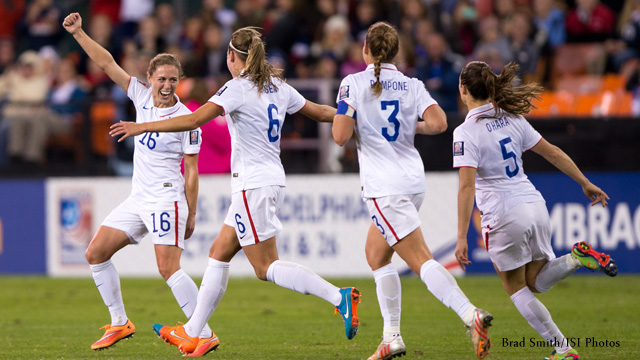LeBolt: Are national team players born or made?

 If you want to be the best at something, study the approach used by people who are doing it well. Then figure out a way to do it even better. That, in a nutshell, is my strategy for life. Hey, why re-invent the wheel?
If you want to be the best at something, study the approach used by people who are doing it well. Then figure out a way to do it even better. That, in a nutshell, is my strategy for life. Hey, why re-invent the wheel?
That’s why people who want to improve U.S. soccer player development are studying the characteristics, traits, experiences and developmental pathways of U.S. Women’s National Team players. So reports an article published in the November/December 2014 issue of the Soccer Journal, the official publication of the National Soccer Coaches Association of America (NSCAA).
If you want to do it like the best, you gotta figure out how they’re doing it.
Dr. Matt Robinson, an Associate Professor at the University of Delaware and Director of Coaching Management for the NSCAA, obtained the majority of the data from a survey sent to 396 subjects who participated in at least one USWNT camp during 2011-2012. Subjects were participants in U-14 to U-23 national team training camps, ranging in age from 13-23. Sixty-five percent of those surveyed responded.
Dr. Robinson’s research is animated by The Talent Code, Daniel Coyle’s popular book, whose premise is that there are variables associated with talent which are essential to develop and create it. Particularly intriguing is the notion of an “ignition” that motivates or inspires an individual to “commit to an activity and pursue it to greatness.” What is the key for players who reach the national team level?
Robinson’s study attempted to answer two questions:
- Who should we be inviting to the national camp?
- What leads us to believe she can be a senior national team player one day?
The results of his survey were used to develop a profile, or description, of the national camp invitees and to identify potential ignition points. This article is the first in a series which will report on player’s responses in an attempt to assess these traits:
- Environment – people who have influenced and supported them
- Experiences that were most beneficial in their soccer development
- Geography or location for development
- Psychological profile
- Physical capabilities
- Aspirations and hopes for soccer and when they began
This study was undertaken in an attempt to establish a more evidence-based approach when identifying players and creating future players pathways for the youth national team programs. Robinson has a unique perspective, with access to nation level coaches from multiple sports and experience leading an international coaching education program.
One country with a small population and limited financial resources but who has had international success found it necessary to be “efficient, deliberate and scientific in identifying talent because they cannot afford to waste time, energy and money on an athlete who may never make it to a national team,” said this coach. “The United States can afford to mess up.”
Ouch. Has our plentiful talent led to a lot of waste? Is it messing up to train kids in sports when they won’t ever “make it”? Should we instead be investing our dollars in things that will actually pan out for our kids?
In pursuit of the scientific and efficient, this research has examined these variables: family status and birth order, educational environment, parental involvement and influence, participation of parent in other sports and particularly soccer. They are seeking to identify an “ignition trigger” for female soccer players who have been identified as youth national level players.
Here is the prevailing profile.
- 84% live with both parents (national average 63%)
- 95% have a sibling (rate of only children 20-25% nationally)
- Of those with siblings, 74% have an older sibling
- Average difference from older sibling 3.08 years
- Gender of older sibling insignificant
- 76% of older siblings played sports
- 73% of older siblings played soccer
- 63% of mothers volunteered within the sport organization in some capacity (72% never coached)
- 52% of fathers volunteered in some capacity, 50% having coached and 56% having trained daughters individually
- 79% of mothers played sports (youth, HS, College or pro)
- 91% of fathers played sports (youth, HS, college or pro)
- Mothers and fathers far exceed national averages for post secondary education
Robinson concludes that the family environment and coincidental birth order is important in shaping these players. He highlights the benefits of having an older sibling with whom to compete, suggesting this offers a natural “playing-up” environment which may create a motivation not to be “left behind.”
He concludes that the inherent struggles of being a younger sibling lead players to challenge themselves, enjoy those challenges and become accustomed to facing adversity. This, he contends, is exactly what we’re helping kids avoid when we hold them back “until they’re ready” to enter a new or challenging situation (like kindergarten).
What doesn’t go without saying is the security that comes with knowing you’re not going to be cut from the home team.
One might conclude from this data that if you wanted to make the national team it’s a good idea to be born into a “traditional” family with athletic, well-educated, involved parents, who have multiple kids — the more, the better just to increase the odds — and the resources and free time for extracurricular sports, especially soccer.
Of course, profiles don’t tell us everything, and we know they can even be dangerous, taken to extremes. These are simply descriptive, so let’s not make them predictive, but they do raise questions:
- Where are the kids from “non-traditional” families?
- What about kids who don’t have the resources?
- If my parents weren’t athletes, should I hang up the cleats?
- If I’m the oldest kid, should I shelve my career in favor of my siblings who are better positioned for success?
- If I don’t have time to volunteer with the soccer organization, am I hurting my kid’s chances?
- And of course, what has talent got to do with it?
There are even stickier questions:
- If we can identify especially capable individuals (mentally, physically, socially and environmentally) at a young age, should we?
- Is our plentiful talent an excuse for the money-pit our youth soccer system now seems to be to so many parents?
- What if I have given my kid the support, resources and sibling struggle environment to develop his/her soccer and physical skills but he/she has never made the commitment?
Is it more than talent that tips the scales? Can we identify this? Can we measure it? Shouldn’t we have a more systematic and scientific approach to building it? supporting it? growing it? Certainly our current national team player pool should be a good place to start looking.
What is it that ignites people to give it their all and then some?
If you’re passionate about something — your career, your family, your art, your sport, your dog training, your cooking, your whatever — what was it that ignited you?
SOCCERWIRE MARKETPLACE
- visitRaleigh.com Showcase Series 2025, hosted by NCFC Youth
- OFFICIAL MANCHESTER CITY SOCCER CAMPS
- Wanted Licensed Youth Soccer Coach
- Join Official Elite Summer Soccer Camps with Europe’s Top Pro Clubs!
- The St. James FC Travel Staff Coach - North (Loudoun) & South (Fairfax)
- The St. James FC Girls Academy (GA) Head Coach - 2 teams
- The St James FC Boys Travel Tryouts
- OFFICIAL BAYERN MUNICH SUMMER CAMPS U.S.
- JOIN THE ALLIANCE!
- OFFICIAL FC BARCELONA CAMPS U.S.











